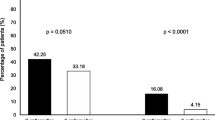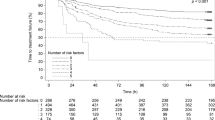Abstract
Purpose
The triplet antiemetic regimen is recommended for cisplatin-based highly emetogenic chemotherapy, in the current guidelines for antiemetic prophylaxis. Although risk factors related to chemotherapy-induced nausea and vomiting (CINV) have been identified by several prior studies, there are only few studies evaluating risk factors associated with the prophylactic triplet antiemetic therapy, particularly in palonosetron use. The present study aimed to reveal the risk factors related to CINV development in patients receiving cisplatin and to compare CINV risk factors between palonosetron and granisetron use.
Methods
In total, 825 patients in a phase III trial receiving palonosetron with graniestron were evaluated. Multivariate logistic regression models were used to predict risk factors associated with CINV development. Additionally, risk factors associated with CINV development were separately evaluated in each treatment group.
Results
Multivariate analysis of the entire study group revealed that sex, age, cisplatin dose, and granisetron use were significant and independent factors affecting CINV development in the overall phase. Similarly, sex and age were risk factors for CINV in both treatment groups. Kaplan–Meier curves classified by each treatment group showed no significant difference between the groups among patients without any risk factors for CINV (P = 0.353). Conversely, complete response rates for patients with at least one risk factor were higher in patients receiving palonosetron (P = 0.049).
Conclusions
This analysis revealed the importance of previously reported CINV risk factors when using triplet antiemetics. Palonosetron might be preferred for patients with at least one risk factor.


Similar content being viewed by others
References
Fernández-Ortega P, Caloto MT, Chirveches E, Marquilles R, Francisco JS, Quesada A, Suárez C, Zorrilla I, Gómez J, Zabaleta P, Nocea G, Llombart-Cussac A (2012) Chemotherapy-induced nausea and vomiting in clinical practice: impact on patients’ quality of life. Support Care Cancer 20:3141–3148
Bloechl-Daum B, Deuson RR, Mavros P, Hansen M, Herrstedt J (2006) Delayed nausea and vomiting continue to reduce patients’ quality of life after highly and moderately emetogenic chemotherapy despite antiemetic treatment. J Clin Oncol 24:4472–4478
Wong EH, Clark R, Leung E et al (1995) The interaction of RS 25259-197, a potent and selective antagonist, with 5-HT3 receptors, in vitro. Br J Pharmacol 114:851–859
Rojas C, Li Y, Zhang J et al (2010) The antiemetic 5-HT3 receptor antagonist palonosetron inhibits substance P-mediated responses in vitro and in vivo. J Pharmacol Exp Ther 335:362–368
Rojas C, Slusher BS (2015) Mechanisms and latest clinical studies of new NK1 receptor antagonists for chemotherapy-induced nausea and vomiting: rolapitant and NEPA (netupitant/palonosetron). Cancer Treat Rev 41:904–913
Hesketh PJ, Bohlke K, Lyman GH, Basch E, Chesney M, Clark-Snow RA, Danso MA, Jordan K, Somerfield MR, Kris MG, American Society of Clinical Oncology (2016) Antiemetics: American Society of Clinical Oncology focused guideline update. J Clin Oncol 34:381–386
Takeuchi H, Saeki T, Aiba K, Tamura K, Aogi K, Eguchi K, Okita K, Kagami Y, Tanaka R, Nakagawa K, Fujii H, Boku N, Wada M, Akechi T, Udagawa Y, Okawa Y, Onozawa Y, Sasaki H, Shima Y, Shimoyama N, Takeda M, Nishidate T, Yamamoto A, Ikeda T, Hirata K (2016) Japanese Society of Clinical Oncology clinical practice guidelines 2010 for antiemesis in oncology: executive summary. Int J Clin Oncol 21:1–12
Roila F, Molassiotis A, Herrstedt J, Aapro M, Gralla RJ, Bruera E, Clark-Snow RA, Dupuis LL, Einhorn LH, Feyer P, Hesketh PJ, Jordan K, Olver I, Rapoport BL, Roscoe J, Ruhlmann CH, Walsh D, Warr D, van der Wetering M, participants of the MASCC/ESMO Consensus Conference Copenhagen 2015 (2016) 2016 MASCC and ESMO guideline update for the prevention of chemotherapy- and radiotherapy-induced nausea and vomiting and of nausea and vomiting in advanced cancer patients. Ann Oncol 27(suppl 5):v119–v133
Aapro M, Molassiotis A, Dicato M, Peláez I, Rodríguez-Lescure Á, Pastorelli D, Ma L, Burke T, Gu A, Gascon P, Roila F, on behalf of the PEER investigators (2012) The effect of guideline-consistent antiemetic therapy on chemotherapy-induced nausea and vomiting (CINV): the Pan European Emesis Registry (PEER). Ann Oncol 23:1986–1992
Gilmore JW, Peacock NW, Gu A, Szabo S, Rammage M, Sharpe J, Haislip ST, Perry T, Boozan TL, Meador K, Cao X, Burke TA (2014) Antiemetic guideline consistency and incidence of chemotherapy-induced nausea and vomiting in US community oncology practice: INSPIRE study. J Oncol Pract 10:68–74
Abunahlah N, Sancar M, Dane F, Özyavuz MK (2016) Impact of adherence to antiemetic guidelines on the incidence of chemotherapy-induced nausea and vomiting and quality of life. Int J Clin Pharm 38:1464–1476
Lohr L (2008) Chemotherapy-induced nausea and vomiting. Cancer J 14:85–93
Hesketh PJ (2008) Chemotherapy-induced nausea and vomiting. N Engl J Med 358:2482–2494
Pollera CF, Giannarelli D (1989) Prognostic factors influencing cisplatin-induced emesis. Definition and validation of a predictive logistic model. Cancer 64:1117–1122
du Bois A, Meerpohl HG, Vach W et al (1992) Course, patterns, and risk-factors for chemotherapy-induced emesis in cisplatin-pretreated patients: a study with ondansetron. Eur J Cancer 28:450–457
Tamura K, Aiba K, Saeki T et al (2015) Testing the effectiveness of antiemetic guidelines: results of a prospective registry by the CINV Study Group of Japan. Int J Clin Oncol 20:855–865
Sekine I, Segawa Y, Kubota K, Saeki T (2013) Risk factors of chemotherapy-induced nausea and vomiting: index for personalized antiemetic prophylaxis. Cancer Sci 104:711–717
Sullivan JR, Leyden MJ, Bell R (1983) Decreased cisplatin-induced nausea and vomiting with chronic alcohol ingestion. N Engl J Med 309:796
Suzuki K, Yamanaka T, Hashimoto H, Shimada Y, Arata K, Matsui R, Goto K, Takiguchi T, Ohyanagi F, Kogure Y, Nogami N, Nakao M, Takeda K, Azuma K, Nagase S, Hayashi T, Fujiwara K, Shimada T, Seki N, Yamamoto N (2016) Randomized, double-blind, phase III trial of palonosetron versus granisetron in the triplet regimen for preventing chemotherapy-induced nausea and vomiting after highly emetogenic chemotherapy: TRIPLE study. Ann Oncol 27:1601–1606
Expert Consultation WHO (2004) Appropriate body-mass index for Asian populations and its implications for policy and intervention strategies. Lancet 363:157–163
Hesketh PJ, Aapro M, Street JC, Carides AD (2010) Evaluation of risk factors predictive of nausea and vomiting with current standard-of-care antiemetic treatment: analysis of two phase III trials of aprepitant in patients receiving cisplatin-based chemotherapy. Support Care Cancer 18:1171–1177
Navari RM, Qin R, Ruddy KJ, Liu H, Powell SF, Bajaj M, Dietrich L, Biggs D, Lafky JM, Loprinzi CL (2016) Olanzapine for the prevention of chemotherapy-induced nausea and vomiting. N Engl J Med 375:134–142
Jin Y, Sun W, Gu D et al (2013) Comparative efficacy and safety of palonosetron with the first 5-HT3 receptor antagonists for the chemotherapy-induced nausea and vomiting: a meta-analysis. Eur J Cancer Care 22:41–50
Popovic M, Warr DG, Deangelis C et al (2014) Efficacy and safety of palonosetron for the prophylaxis of chemotherapy-induced nausea and vomiting (CINV): a systematic review and meta-analysis of randomized controlled trials. Support Care Cancer 22:1685–1697
Du Q, Zhai Q, Zhu B et al (2017) Economic evaluation of 5-HT3 receptor antagonists in combination with dexamethasone for the prevention of ‘overall’ nausea and vomiting following highly emetogenic chemotherapy in Chinese adult patients. J Oncol Pharm Pract 23:403–412
Molassiotis A, Stamataki Z, Kontopantelis E (2013) Development and preliminary validation of a risk prediction model for chemotherapy-related nausea and vomiting. Support Care Cancer 21:2759–2767
Dranitsaris G, Molassiotis A, Clemons M, Roeland E, Schwartzberg L, Dielenseger P, Jordan K, Young A, Aapro M (2017) The development of a prediction tool to identify cancer patients at high risk for chemotherapy-induced nausea and vomiting. Ann Oncol 28:1260–1267
Acknowledgements
We wish to thank all the patients and staff at all study institutions who participated in this study.
Author information
Authors and Affiliations
Corresponding author
Ethics declarations
Conflict of interest
DT reports grants from Yakult and personal fees from Chugai, Kyowa Hakko Kirin, Sawai, Taiho, and Nippon Kayaku outside the submitted work. KS reports personal fees from Taiho, Eli Lilly, Bristol-Myers Squibb, Astra Zeneca, Ono, and MSD outside the submitted work. KG reports grants and personal fees from Chugai, Taiho, and Ono; grants from Takeda, during the conduct of the study; grants and personal fees from AstraZeneca, Boehringer Ingelheim, Bristol-Myers Squibb, Daiichi Sankyo, Eli Lilly, MSD, Novartis, Pfizer, Kyowa Hakko Kirin, Merck Serono, RIKEN GENESIS, and GlaxoSmithKline; grants from Eisai, Sumitomo Dainippon Pharma, Oxonc, Astellas Pharma, AbbVie Stemcentrx, and Ignyta; personal fees from Nippon Kayaku, ABBOTT, Quintiles, Life Technologies Japan, and SRL, outside the submitted work. RM reports personal fees from Chugai, Taiho, Yakult, Novartis, Boehringer Ingelheim, Meiji Seika Pharma, Janssen, and Sawai outside the submitted work. NS reports grants and personal fees from Boehringer Ingelheim, personal fees from Eli Lilly, Astra Zeneca, Daiichi Sankyo, MSD, Chugai, Taiho, Ono, and Bristol-Myers Squibb outside the submitted work. HH reports personal fees from Taiho, Ono, and Eli LIlly outside the submitted work. TH reports grants from Yakult, and Sawai, personal fees from Meiji Seika Pharma, and Towa outside the submitted work. TY reports grants and personal fees from Taiho, and Takeda, personal fees from Chugai, and Boehringer Ingelheim outside the submitted work. NY reports grants and personal fees from KYORIN, Ono, Taiho, Pfizer, Chugai, MSD, Daiich Sankyo, and Astra Zeneca, personal fees from M3., Otsuka Pharmaceutical, JASMIN, Bristol-Myers Squibb, Eli Lilly, Novartis Pharma, and FUJIFIRM, grant from Maruho, Shionogi, Meiji Seika Pharma, Quintiles, PAREXEL International, and ACMEDICAL outside the submitted work. All remaining authors have declared no conflicts of interest.
Electronic supplementary material
ESM 1
(DOCX 31 kb)
Rights and permissions
About this article
Cite this article
Tsuji, D., Suzuki, K., Kawasaki, Y. et al. Risk factors associated with chemotherapy-induced nausea and vomiting in the triplet antiemetic regimen including palonosetron or granisetron for cisplatin-based chemotherapy: analysis of a randomized, double-blind controlled trial. Support Care Cancer 27, 1139–1147 (2019). https://doi.org/10.1007/s00520-018-4403-y
Received:
Accepted:
Published:
Issue Date:
DOI: https://doi.org/10.1007/s00520-018-4403-y




